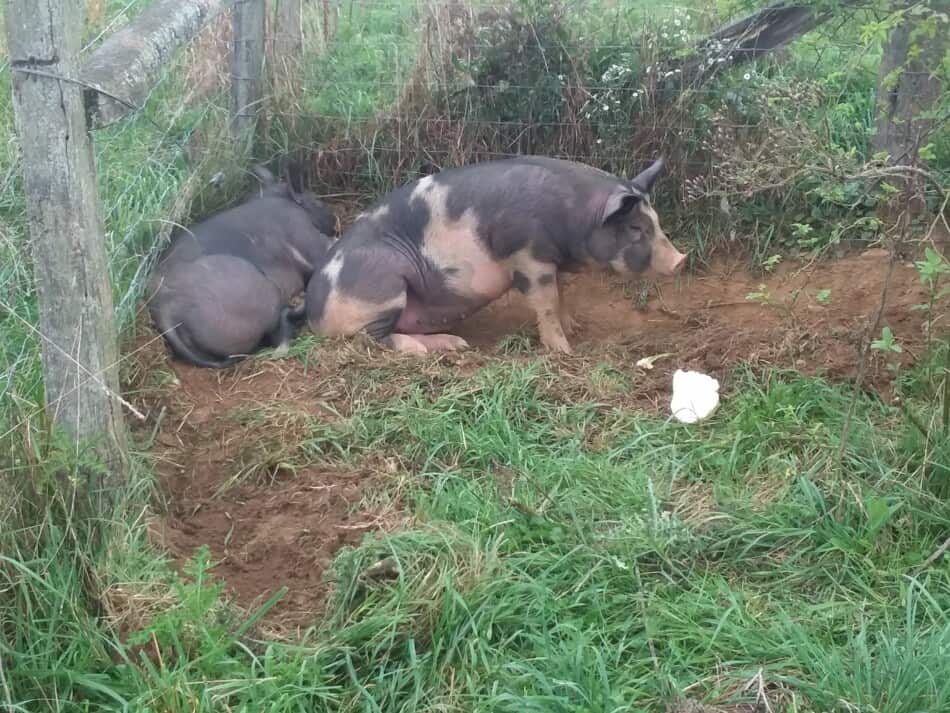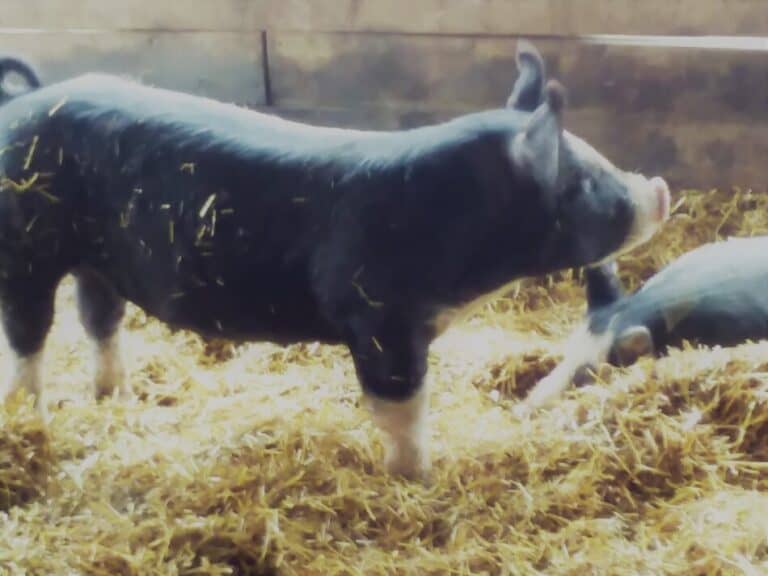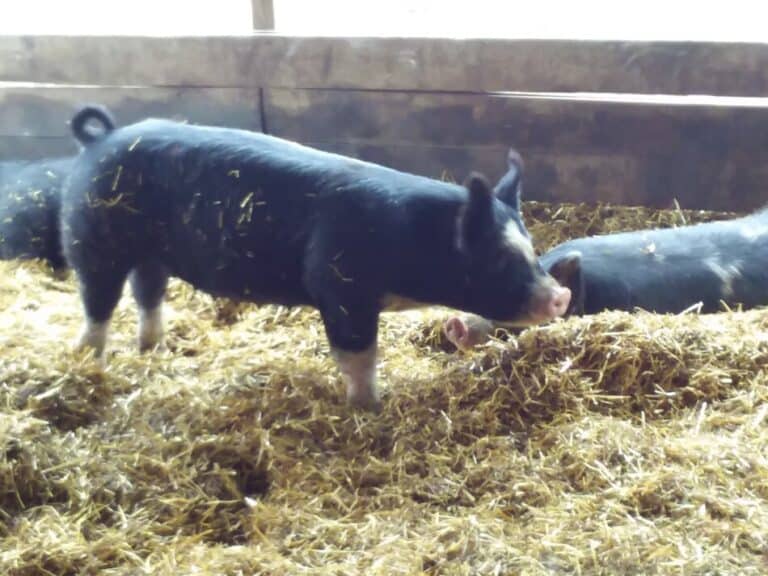What Is A Good Pig Feed Mix? A Few Options

Now that you have decided to raise a few pigs, you’ll want to figure out what you should feed them. If you have looked around online, you’ll know there are a lot of opinions out there!
Here’s the challenge, which ones are providing common sense advice and which opinions are just folks trying to get your attention? You need a good feed mix for your pigs, but what will work for you and your wallet?
The best feed mix for pigs is a premade pig feed from a feed mill. If pig feed is unavailable or prohibitively priced, you can make your own pig feed out of locally available grains like barley, wheat and oats along with a protein source and a mineral mix.
Is Raising Pigs For Meat Worth It? will walk you through all of the costs you need to figure into your budget when you raise your own pork.
How To Naturally Raise Happy, Healthy Pigs will go over the things you should provide to give your pigs a good life.
Best feed mix for your pigs is found at the feed mill
The best feed mix for your pigs is a pre made pig feed found at a feed mill. This feed will be formulated to give your pigs everything they need to grow well for you.
By feed mill, I mean a place that actually grinds feed and usually sells feed in 100 pound sacks. This will be the best place for you to buy your feed, the price is a steal compared to other feed sources!
If you are not fortunate enough to have a feed mill within a reasonable driving distance, your next best shot at pig feed is the 50 pound brand name feed bags at your local feed store.
The prices here will be higher than at a feed mill, but this is feed that will be formulated for your pigs, no work is needed on your part other than opening the bag and giving it to your pigs!
Use locally available grains for your pig feed
If you are not happy with the local pig feed options, now we move to making your own feed.
This will take some work on your part to figure up prices and source some basic ingredients to make your custom blend pig feed. However, once you figure out your mix, you’ll be saving money every time you make pig feed.
Generally, pig feeds are formulated based on corn as the main ingredient, with a soybean meal used to increase the protein percentage and have a mineral mix included.
The reason corn is the main ingredient is that most pig growing areas are also corn growing areas, at least in the U.S.
This works great in areas that have a lot of corn, but what about areas that are not abundant in corn? Here are some small grain alternatives to corn that maybe more easily sourced in your area.
| Small Grain Alternative To Corn (partial or complete replacement) | up to 25# pig | 25-50# pig | 50-125# pig | 125-315# pig |
| Barley | 100% | 100% | 100% | 100% |
| Oats | 15% | 30% | 35% | 40% |
| Rye | 0% | 10% | 25% | 35% |
| Triticale | 20% | 30% | 100% | 100% |
| Wheat | 100% | 100% | 100% | 100% |
Use a grain that is easily sourced in your area. This could be rice, milo, etc.
You’ll have to search around to see the replacement proportions for your pigs, but generally if you can eat it so can pigs. You’ll just have to make sure the total ration gives the pigs the protein they need to grow well.
Soybean meal is the most common protein source in pig feed
Soybean meal is commonly used in pig feed to raise the protein percent of the feed up to the levels your pigs need.
This is because the protein of corn is low (like 7%) but the protein the pigs need is 16-12.6% depending upon size. The lack of protein in corn (or other small grains) is made up for with soybean meal, because it is high in protein.
I’m not saying soybean meal is the only choice or even the best choice, it is just the most commonly available and most commonly used choice to raise protein levels in livestock feeds.
If you are not a soy fan, you have some alternatives, but they may be hard to find. If you are okay with soy, just not GMO soy, you can get non GMO or organic soy to use in your feed.
Non GMO grains are becoming more common feed ingredients, so getting non GMO soy may just be easier than you think. Ask for non GMO soybean meal at your feed mill and see what they have for you.
If you are hoping to avoid soy altogether, it makes your ration more complicated to balance.
Soybean meal is used because it is easy to find and very high in protein compared to other grains so a little makes a big difference.
The easy answer to a soybean meal alternative is peanut meal, which is great for the southeast, but not so great for anywhere else due to price.
The best answer I have for you to completely avoid soy is to call your local feed mill and see what they can come up with. If you have an organic feed supplier near you, call them first.
Use bagged ingredients to make your own pig feed
You can also buy all of the ingredients separately an mix them yourself to make your own pig feed.
Local prices will vary quite a bit on these ingredients. Be sure to do math, it may be cheaper per bag to buy the feed already mixed for you!
This was the case for me, I ran the numbers and found mixing my own out of 50# bags of ingredients (cracked corn, soybean meal and mineral mix) was actually more expensive than buying already made pig feed.
If you want to try your own feed, here are the percentages of each ingredient for 50-80 pound pigs:
- 76.3 % corn, ground or cracked
- 20.75% soy meal
- 3% mineral premix
Make sure you have a scale that can accurately measure your ingredients.
When we make small batches of feed, we use two scales, a big one for the larger amounts that we hang a bucket from and a small digital one for the tiny ingredients like the mineral mix.
If you wanted to make a 100 pound batch of pig feed, you would use these percentages exactly as written, no math is needed.
For example: for 100 pounds of feed, use 76.3 pounds of ground or cracked corn.
If you wanted a smaller batch, you would take the batch total weight multiplied by the ingredient percentage.
For example: for a 50 pound total batch of pig feed you need 50 x 76.3%, which is 38.15 pounds of corn. (Use the % sign when you put this in the calculator, other wise you need to use .763, which is the same as 76.3%.)
Check out my Pig Feed Ration page for rest of mixes.
Please note that as the batches get smaller the ingredient amounts get more difficult to accurately weigh out. Make sure you have a scale that can accurately measure your ingredients.
You’ll want to change the mix as the pigs grow, it will save you some money. This is good news, the change is a shift away from the expensive ingredients (soy) to a lower protein mix.
If you don’t want to change the mix, that’s okay, just know it will be costing you a little more in total cash to feed your pig to butchering weight than if you had redone the mix when the pigs are big enough.
The University of Minnesota Extension has an article on Mixing your own swine feed, if you want to check it out. It has more of a “big ag” reader in mind, but still has some interesting information.
Ferment the pig feed by adding water
Fermenting your pig’s feed can increase digestibility, meaning you get more use out of the feed by your pigs than you would from unfermented pig feed.
So, you would still have to buy ground pig feed to start with, but should you choose to ferment it, the idea is you will buy less feed, overall. ABC Acres ferments their pig feed for 12 hours.
I have never fermented pig feed myself, but I have seen multiple folks on video do it for their pigs saying that it increases digestibility of the feed and reduces feed wasting.
The basic idea is to put a feedings worth of ground feed in a bucket then add water to make it wet. Now give the natural bacteria time to work, a day or two, then you feed it in pans.
Of course, you need to get a system going here, to get the next day’s worth of feed fermenting today and have some fermented feed that you started already for use today.
The fermentation will work faster in warmer weather.
Check out Red Tool House on YouTube for more on fermenting pig feed. I have heard him mention it, but am not sure of the exacts.
I do not like to carry heavy buckets, so I don’t ferment feed. If I could figure out an easy way to ferment feed without carrying it, I’d be much more willing to try this one.
If you are willing to carry the heavier buckets and like the idea, give fermenting the feed a shot.
Supplement your pigs with grass, hay or vegetables
Your pigs can eat foods other than pig feed, like grass, hay or vegetables. Most folks would feed these things in addition to the normal pig feed and let the pigs choose what to eat.
What if there are no easily sourced feeds in your area, even the “alternative grains” are not available? This is more of a challenge, but it’s still doable.
Sugar Mountain Farm has this exact problem, grain is prohibitively expensive where they live so they have found other sources of feed for their pigs.
Please read carefully and note that the pigs are normally still getting high calorie foods, it’s just that the high calories are coming from sources other than ground pig feed.
You will need to find some high calorie feed sources for your pigs, (unless you feeder pigs from Sugar Mountain Farm’s genetics) they need to eat more than just grass to support their growth.
The easiest way to make sure that your pigs have all of the energy and nutrients they need is to give them free choice ground pig feed and grass, vegetables, hay, etc. as a supplement to the pig feed.
Resources:
Small Grains For Livestock, by Dr. Pete Lammers, I used Table 8 and changed the * which meant no limit to 100% since I am listing allowable percent and the table originally listed upper limit percentages of the pig ration




